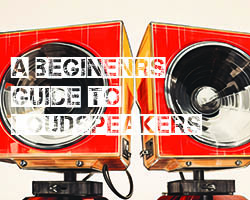How many times have you listened to a set of ‘speakers in a showroom to be surprised, or even disappointed when after purchasing, dragging them (carefully) home and impatiently setting them up only to be rewarded with something that bore no relationship with the sound that you heard at the dealers? Besides the usual caveats of allowing ‘speakers to break-in for 50 hours or more so that the moving parts can free up slightly, what else is there to be concerned with?
It’s probably happened to all of us at some point or other and besides the obvious consideration of checking the ‘speaker loading specifications (to ensure they’re a friendly load for your amplifier) there are quite a number of other considerations. Not least of these is how the ‘speakers “couple” with your listening room, be that a living room or dedicated listening room for those lucky enough.
The room dimensions, damping, the amount of furniture and clutter (or lack of) can all lead to fundamental impacts on ‘speaker performance, hence sound. Place very large ‘speakers in a very small room and you may be plagued with reflections and reinforcement of bass with the room’s own natural resonant frequency which can lead to a muddled boomy result. So are there any hints and tips for maximising your ‘speakers performance? Well, happily, yes.
Loudspeaker Positioning
There are several recognised ways of correct ‘speaker set up, whether these apply will be determined largely on whether you have a dedicated listening room or not. Most of us share or beloved hifi with family and friends in the living room and this isn’t ideal from a placement perspective, as practicalities usually dictate ‘speaker positioning but there are a few hints and tips to get things as good as possible. The following hints and tips are generalised pieces of advice but for more detailed technical reading, there’s loads of information available on the web.
Firstly, unless you use small stand-mounters or other designs which are best placed up close to the rear walls, move your ‘speakers out, if possible by at least a metre from rear walls. Also, if possible moved them a metre or more (more is preferable) out from the sidewalls. Having them too close to back or side walls increases the sound wave reflections which can muddle sound, reinforce certain bass frequencies out of phase, leading to boomy muddled lower registers and can confuse sound staging. Next, measure the distance between centres of the two ‘speakers. Conventional wisdom states that the best distance to preserve sound staging is around 7 to 8 feet apart (2.1 to 2.45m) with the listener positioned around 1 to 1.2 times that distance back from the front plane of the ‘speakers and somewhere in between the two. This is a matter for experimentation since all rooms and ‘speakers differ.
It helps to toe the ‘speakers in so that when seated in the listening position and looking at each loudspeaker, it is facing you front on with the line of the ‘speaker axis passing directly towards you. This is because most tweeter designs (the small ‘speaker transducers responsible for high frequency response) have a very narrow on-axis response. Move too far one side or other of that axis and high frequency volume hence detail drops off. Of course, this can be used to advantage, for example where you find the upper register too bright, then you can re-position the ‘speakers so that they are firing straight down the room, resulting in a fall off in sound pressure level of the high frequencies at the listening position.
There is an alternative method which for a dedicated listening room sometimes works better. This relies on the ‘speakers being placed in “free space” about a third of the way out from the listening position, and that listening position being up against the rear wall (sofa at back of room). The ‘speakers are placed the same distance apart and set up as described for the first example. This often results in deeper (not “boomy”) cleaner bass depending on the distance away to the listening position, plus providing there’s nothing cluttering up the area between ‘speakers and sofa, also results in better sound-staging. This is due to their being fewer reflections from the front wall. You can experiment with exact listening position to get the best in-room response by pulling the sofa back slightly off the rear wall.
So that’s the ‘speakers positioned. Next, look at what you have both between you and the loudspeakers and in between the ‘speakers themselves. It’s not a good idea to place the drivers behind or flush with television sets, book cases or anything else as this can muddle the sound hence the sound-staging and accuracy of the stereo response. Just moving the front baffle of the ‘speakers a small way out in front of such obstacles will often clean up the imaging quite noticeably. The same thing goes for the obligatory coffee tables in front of the listening position. If possible, keep the area between the listener and the ‘speakers clear of such clutter. It’s not always practical to do this so at least choose a low standing table if you must have one!
Positioning of HiFi kit
Source components, especially turn-tables with their very sensitive tonearms and cartridges are very prone to picking up airborne vibration. That is why you should never place them directly to the front (or behind) the ‘speakers. The best position is in another room entirely but since this isn’t practical, the compromise is to place them in between the speakers and far enough behind not to be close to the plane of the front ‘speaker baffle panels. An alternative is to place them to one side, tight up against the room wall far enough back not to be in direct “line of fire”. Microphonics also plays a part with the sound quality impact when applied to amplifiers, particularly valve amplifiers and cause “ringing” if too much microphonic noise is induced into sensitive components, which can destroy detail accuracy. Best to keep components isolated from the kit racks, sideboards or whatever you use as this avoids ground borne vibrations impacting on performance. I always prefer to isolate rather than “couple” components since there’s little point in coupling to a kit rack that itself might suffer from vibration induced by the ’speakers. There are lots of cheap and cheerful ways you can do this from using high mass slate or granite plinths supported on squashy Sorbothane feet or similar materials, with the kit sat atop. The idea is to both isolate and also keep the mounting platform as a dense and heavy material with a natural resonant frequency different to that of the rack so that vibrations aren’t reinforced but are damped.
Room Treatment
Correct acoustic treatment of a listening room can make a startling difference to sound quality…fact. Before tiring of your ‘speakers and itching for another change or upgrade, first consider the relatively cheap option of room treatment. So what does this entail? The idea is to damp out any points where significant reflections take place thus cleaning up the soundwave response. This can be achieved by sound absorption, diffraction or damping. There are specialist acoustic panels which can be bought from any professional studio spars outlets for this purpose or you can make your own using polystyrene sheets or even old egg boxes! Usually, the most effective way to do this is to hire or borrow (or buy) a specialist frequency response analyser which measures in-room response including decay response. These can be expensive but there are I believe certain “Apps” now available for some mobile phones which provide a basic version of this function. Don’t worry if you don’t have access to such specialist kit as there are some basic measures you can take to make some very desirable improvements. Start by placing an acoustic panel on the rear wall behind each ‘speaker about a metre in width and a little taller than the ‘speakers. Next, do the same on the side walls. Finally, you can put panels up on the rear wall or use something like a wall hanging to dampen the sound pressure waves to reduce reflections. The same can be done with the ceiling using diffraction panels to disperse reflections. If its a dedicated listening room then the appearance needn’t bother too much, but for living room spaces, the choice of colours and positioning need more careful consideration. Even things with irregular shapes which help disperse soundwaves will help, like book cases, lamp shades and even ornaments. Clutter is good! Bare minimalist uncarpeted rooms less so…
If you are unfortunate to have a room with a suspended floor as many of us do, there are things you can do to improve the sound. The most serious approach would be to remove floorboards under the speakers and cast a concrete speaker plinth, but not everyone wants to go to that length or indeed can in the case of apartments or flats! The alternative is to place a thin squashy rubber mat onto the floor, then place a dense granite (or similar) plinth on top and sit the ‘speakers on these. It won’t in all cases bring significant improvements, but in many cases it will.
This has been just a brief and general overview but hopefully it’s shown that there’s correct ways to position ‘speakers and incorrect ways plus gives a few hints and tips to improving room acoustics. Happy listening!
Author – Paul at Reference Fidelity Components
















































































































































































































You must be logged in to leave a reply.